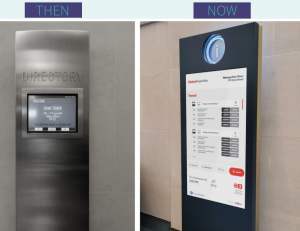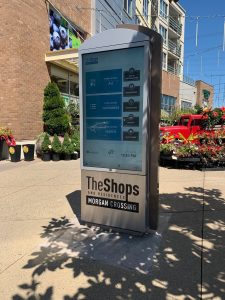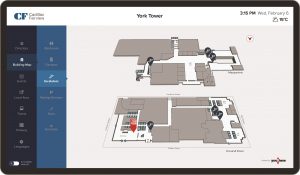There’s an iconic line in automobile advertising that states, “This is not your Father’s Oldsmobile.” It’s a classic slogan that dates back to a series of commercials in the 1980s, which urged people to reconsider what the Oldsmobile brand meant to them by taking a fresh look at how much the model had changed from the previous generation. It’s a compelling message, and one that can be applied to another fast-evolving (although admittedly less ‘sexy’) product: digital building directories.
Coincidently, around the same time as those Oldsmobile car advertisements were running, the first commercially available touchscreens were beginning to hit the market. Over the next decade, a few brave early adopters started installing directories using touch technology in their buildings. And just as the cars of the 1980s bear little resemblance to the cars of today, those early directories bear little resemblance to today’s models in either form or function.

That, however, is where the automobile analogy stops. While no one today would mistake a 1980’s car for a current model, we still struggle to convince a surprisingly large number of people that the directories of today can do so much more than direct visitors to the correct floor.
Let me explain. True, like other products with screens (e.g., televisions, computer monitors, etc.), there are some obvious trends in directories from a physical standpoint, with size being the most common. When these first touchscreens entered the market some 20 years ago, screen sizes ranged between 15″ and 22″ (like televisions, measured diagonally), and this evolved only very slowly. Even eight to ten years ago, screen sizes had increased only modestly, with 32” perhaps the most common size for “larger format” touchscreens that found their way into shopping malls and other larger venues.
 Today, that has all changed. 42” – 55” screens are now the most commonly installed sizes and 70” and larger screens are popping up with increasing frequency at much more reasonable price points than even two or three years ago. Touch technologies have also continued to evolve, with touch films being applied to regular, glass-fronted monitors to compete with touchscreens which, in turn, have continued to employ increasingly sophisticated (but reliable) technologies. At the same time, those touchscreens are now some 40%+ thinner than those of five years ago. Picture sharpness is yet another attribute that’s seen significant evolution, with HD being replaced by UHD and 4K resolution, and 8K is on the way.
Today, that has all changed. 42” – 55” screens are now the most commonly installed sizes and 70” and larger screens are popping up with increasing frequency at much more reasonable price points than even two or three years ago. Touch technologies have also continued to evolve, with touch films being applied to regular, glass-fronted monitors to compete with touchscreens which, in turn, have continued to employ increasingly sophisticated (but reliable) technologies. At the same time, those touchscreens are now some 40%+ thinner than those of five years ago. Picture sharpness is yet another attribute that’s seen significant evolution, with HD being replaced by UHD and 4K resolution, and 8K is on the way.
That said, software features and functionality are among the biggest changes we see occurring in digital directories. Over the past decade, digital directories have moved from a place to locate tenants to interactive digital information hubs for the building. Now, the opportunity to provide relevant information to visitors as they enter the building is almost endless.
For example, the features we at youRhere now routinely deploy on our building directories would include:
- Building amenities such as washrooms, food and beverage options, and entrances to underground parking;
- Live local traffic information showing the arrival time of the next bus or train;
- Links to third-party data feeds showing news, weather, sports or entertainment;
- A neighborhood map showing local restaurants or tourist attractions;
- Inter-building connectivity if the building is part of a complex or connected to other properties via underground or elevated walkways or paths;
- Accessibility features, and not just for the mobility impaired but also for the visually impaired through the incorporation of headphone jacks and special keyboards; and
- Additional languages to serve populations whose first language is not English.

Finally, while a great deal of the focus of directory information is naturally directed toward building visitors, tenants and employees of the building can also benefit from the information displayed on the directories.
Along with a number of the features mentioned above (e.g., transit information, news feeds, sports updates, etc.) we at yourHere have found that sustainability information reflecting efforts by building tenants and management alike to reduce energy consumption or waste production generates significant interest and pride among those who work at the property. Similarly, building announcements such as welcoming a new tenant or information about building initiatives (e.g., tenant appreciation events, blood donor clinics, holiday toy or food drives, Earth Day promotions, etc.) foster a sense of community among those who call the building home for a good portion of their day.
All told, today’s Digital Information Hub is not your Father’s (or Mother’s) Building Directory indeed.
Scot Martin is CEO of youRhere, a leading provider of interactive digital signage solutions for commercial, retail, healthcare, and educational properties across Canada. For more information, visit www.youRhere.ca.





